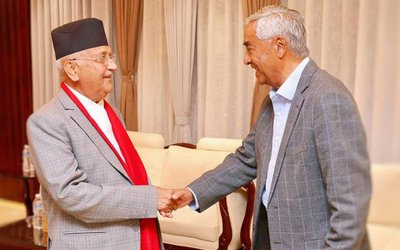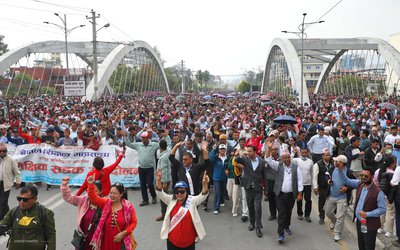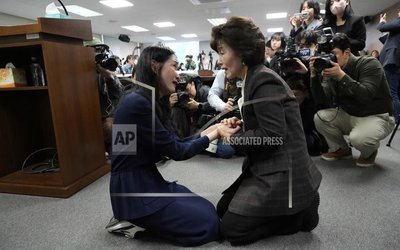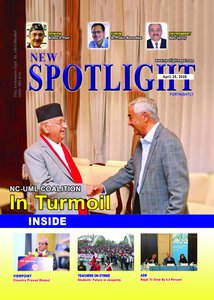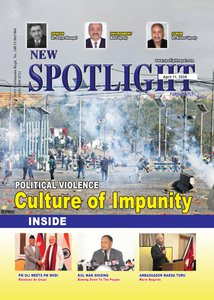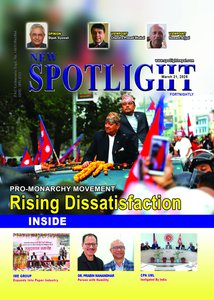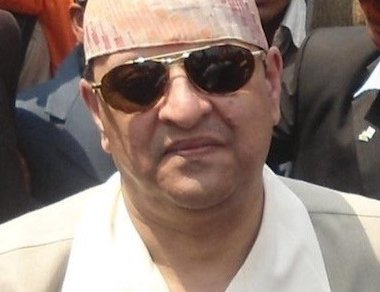
THE highly anticipated royalist demonstrations on March 28 devolved into chaos and violence, raising questions about the future of the monarchy restoration project in Nepal. Two people lost their lives, around 100 were injured, and numerous vehicles and businesses were set ablaze, prompting the government to impose a curfew in parts of Kathmandu and deploy the army.
Two senior leaders of the monarchist Rastriya Prajatantra Party (RPP) – senior vice-president Rabindra Mishra and general secretary Dhawal Shamsher Rana – along with several other individuals, are in custody for incitement. At least a dozen people were arrested for looting a department store.
The police are searching for the chief protest organizer, Durga Prasai, who escaped from the scene. Government supporters held a separate protest on the same day in a different part of Kathmandu, which passed peacefully.
The former vice-chancellor of the Nepal Academy, Jagman Gurung, has been appointed as the new head of the Monarchy Reinstatement Movement Committee. He replaces Navaraj Subedi, who is currently under house arrest. Gurung will now serve as the acting leader of the committee as royalist groups advance their protest plans.
The government and its allies immediately held former king Gyanendra accountable for the chaos, leading to a reduction in his state-provided security detail. Three days later, Prime Minister Khadga Prasad Oli informed parliament that Mr. Shah was responsible for the mayhem and asserted that the guilty would not escape punishment.
The government is under pressure from both the ruling parties and the opposition to arrest the ex-monarch and revoke his passport. Kathmandu Municipality imposed a fine of nearly Rs. 800,000 on Mr. Shah for the damage caused to public property and the environment during the protests. The ex-king has not made a public statement on the violent protests or the allegations against him. Some reports suggest that he has been placed under informal house arrest.
The pro-monarchy movement in Nepal has intensified since February, following a message by Mr. Shah on Democracy Day. In his video message, the deposed monarch urged Nepalis to join him in ‘saving the nation’. Since then, monarchists have staged multiple rallies across Nepal, demanding the restoration of the 240-year-old institution.
The immediate narrative following the March 28 anarchy was that the pro-monarchy cause had been severely damaged – perhaps irretrievably – by the actions of the protesters. However, video footage of the events began circulating on social media, fueling speculation that security forces had used excessive force before any real security threat emerged. Protesters claimed they were merely responding to police provocation and asserted that government and party provocateurs had infiltrated the demonstration.
The most horrific episode was the burning alive of video journalist Suresh Rajak when the building he was working in was set ablaze. The government blamed the protesters for the arson, a charge they vigorously deny. It is not clear whether the second deceased, Sabin Maharjan, was a protester or a bystander. However, some eyewitnesses claim he was the victim of police highhandedness in an area that was not a security risk.
Such conflicting accounts regarding the events before and during the protests have challenged the initial assertion of a significant defeat for the royalist cause. The RPP and other groups have pledged to persist with demonstrations as part of a larger uprising against the government and the federal secular republican system.
The protests were fueled by escalating public frustration over corruption, mismanagement, impunity, and the government’s overall lack of direction. Even some members of the ruling parties and advocates of the republican system concur that the government must alter its approach to regain public support. However, they insist that regressing to a monarchy is not the answer.
Royalists perceive the monarchy as a symbol of national unity and stability. They seek to reinstate the institution along with Nepal’s Hindu state identity, which was abolished in 2008. Some believe Nepal has become overly influenced by foreign powers, particularly India and Western nations, and view the monarchy as a means to reclaim sovereignty and national identity.
Republicans argue that a return to the monarchy is impossible due to insufficient political and public support and constitutional obstacles. They point out that while royalist protests have occurred, they suffer from weak leadership and lack nationwide momentum. Previous controversies surrounding the monarchy also work against a restoration of the institution.
Royalists express confidence that public frustration with the current order will encourage more Nepalis to reconsider the monarchy as a stabilizing force. They argue that the institution has played a crucial role in preserving Nepal’s Hindu identity. Additionally, they maintain that shifting regional political dynamics could lead to either direct or indirect external support for a transition towards monarchy.
For now, the contest will likely continue to take place on the Nepali street.
LINK https://www.linkedin.com/pulse/nepal-revolution-regression-rampage-sanjay-upadhya-yh5ie/
- Nepal: The Status Quo Cannot Hold
- Apr 14, 2025






